Marine Mammal Unusual Mortality Events
Hot Topics 2008 Indian River Lagoon Bottlenose Dolphin Unusual Mortality Event Related Links Criteria for Marine Mammal Unusual Mortality Events |
|
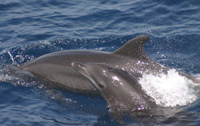 Bottlenose Dolphins (Tursiops truncatus) Photo: NMFS Southwest Fisheries Science Center 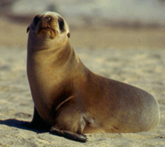 California Sea Lion (Zalophus californianus) Photo: NMFS National Marine Mammal Laboratory |
Overview
An unusual mortality event (UME) is defined under the Marine Mammal Protection Act as:
"a stranding that is unexpected; involves a significant die-off of any marine mammal population; and demands immediate response."
In recent years, increased efforts to examine carcasses and live stranded animals have improved the knowledge of mortality rates and causes, allowing a better understanding of population threats and stressors and the ability to determine when a situation is "unusual." Understanding and investigating marine mammal UMEs is important because they can serve as indicators of ocean health, giving insight into larger environmental issues which may also have implications for human health and welfare.
The marine mammal UME program was established in 1991. From 1991 to the present, there have been 45 formally recognized UMEs in the U.S., involving either single or multiple species and dozens to hundreds of individual marine mammals per event. The table below indicates the years, species, and cause (determined or suspected) for each UME. UMEs have occurred in and along the Atlantic, Gulf of Mexico, and Pacific coasts of the U.S., as well as Alaska and Hawaii.
The states with the most declared UMEs are:
- California
- Florida
The most common species involved in UMEs are:
Causes have been determined for 24 of the 45 UMEs documented since 1991. Causes of UMEs include:
- infections
- biotoxins (poisonous substances produced by a living organism)
- human interactions, and
- malnutrition
Since 1996, UMEs associated with biotoxins from harmful algal blooms have become more prevalent. The majority of recent UMEs have been attributed to toxicity from domoic acid [pdf] or brevetoxin [pdf].
Past and Current UMEs
The charts illustrate the data shown in the table below. Click on an image to view a larger size in PDF format. A text version of the charts [pdf] is also available.
| UMEs Per Year | UMEs Per Year by Causes | |
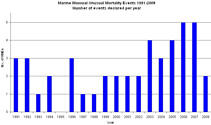 |
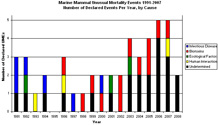 |
| Causes of UMEs | UMEs per Geographic Area | Species Impacted by UMEs | ||
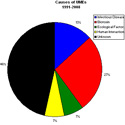 |
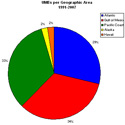 |
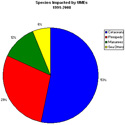 |
| No. | Year | Species | Location | Cause (Category) |
|---|---|---|---|---|
| 46 | 2008 | Bottlenose dolphins | Florida (Indian River) | Undetermined |
| 45 | 2008 | Common dolphins, Atlantic while-sided dolphins | North Carolina- New Jersey |
Undetermined |
| 44 | 2008 | Bottlenose dolphins | Texas | Undetermined |
| 43 | 2007 | Guadaloupe fur seals | Nothwest | Undetermined |
| 42 | 2007 | Large whales | California | Human Interaction |
| 41 | 2007 | Manatees | Florida (SW) | Biotoxin |
| 40 | 2007 | Cetaceans | California | Undetermined |
| 39 | 2007 | Bottlenose dolphins | Texas and Louisiana | Undetermined |
| 38 | 2006 | Manatees | Florida (Everglades) | Biotoxin |
| 37 | 2006 | Harbor porpoises | Pacific Northwest | Undetermined |
| 36 | 2006 | Pinnipeds | North Atlantic | Undetermined |
| 35 | 2006 | Humpback whales | North Atlantic | Undetermined |
| 34 | 2006 | Sea otters | Alaska | Undetermined |
| 33 | 2005-2006 | Bottlenose dolphins | Florida (Panhandle) | Biotoxin |
| 32 | 2005 | Large whales | North Atlantic | Undetermined |
| 31 | 2005 | Harbor porpoises | North Carolina | Undetermined |
| 30 | 2005-2006 | Multi-species (manatees and bottlenose dolphins) | Florida (west coast) | Biotoxin |
| 29 | 2004 | Small cetaceans | North Carolina | Undetermined |
| 28 | 2004 | Small cetaceans | Virginia | Undetermined |
| 27 | 2004 | Bottlenose dolphins | Florida (Panhandle) | Biotoxin |
| 26 | 2003 | Harbor seals and Minke whales | Maine | Undetermined |
| 25 | 2003 | Manatees | Florida (west coast) | Biotoxin |
| 24 | 2003 | Large whales (primarily humpback whales) | Gulf of Maine | Undetermined |
| 23 | 2003 | Sea otters | California | Ecological Factors |
| 22 | 2002 | Manatees | Florida (west coast) | Biotoxin |
| 21 | 2002 | Multispecies (common dolphins, California sea lion, sea otters) | California | Biotoxin |
| 20 | 2001-2002 | Hawaiian monk seals | Hawaii (Northwest Hawaiian Islands) | Ecological Factors |
| 19 | 2001 | Bottlenose dolphins | Florida (Indian River) | Undetermined |
| 18 | 2000 | Harbor seals | California | Infectious Disease |
| 17 | 2000 | California sea lions | California | Biotoxin |
| 16 | 1999-2001 | Gray whales | California, Oregon, Washington | Undetermined |
| 15 | 1999-2000 | Bottlenose dolphins | Florida (Panhandle) | Biotoxin |
| 14 | 1998 | California sea lions | California | Biotoxin |
| 13 | 1997 | Harbor seals | California | Infectious Disease |
| 12 | 1996 | Bottlenose dolphins | Mississippi | Undetermined |
| 11 | 1996 | Manatees | Florida (west coast) | Biotoxin |
| 10 | 1996 | Right whales | Florida, Georgia | Human Interaction |
| 9 | 1994 | Bottlenose dolphins | Texas | Infectious Disease |
| 8 | 1994 | Common dolphins | California | Undetermined |
| 7 | 1993 | Pinnipeds | Washington | Human Interaction |
| 6 | 1992-1993 | Pinnipeds | California | Ecological Factors |
| 5 | 1992 | Bottlenose dolphins | Texas | Undetermined |
| 4 | 1992 | Phocids | New England | Infectious Disease |
| 3 | 1991 | Bottlenose dolphins | Florida (Sarasota) | Undetermined |
| 2 | 1991 | California sea lions | California | Infectious Disease |
| 1 | 1991 | Harbor seals | New York | Infectious Disease |